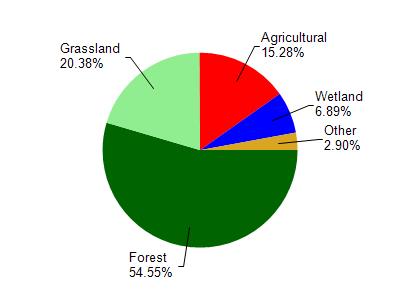Dane
No
No
No
Fish and Aquatic Life
Overview
Little Norway Creek is a spring fed tributary to Bohn Creek. The stream flows through a steep valley. The stream has good water quality and seems to have fairly good trout habitat and the water runs cool in the stream. The stream is not currently managed.
Date 2002
Author Cynthia Koperski
Historical Description
Little Norway Creek -T7N, R6E, Sec. 34, Surface acres = 1, Length = 1.3 miles, Stream order = II, Gradient = 92.3 ft/mile, Base discharge = 0.36 cfs.
Little Norway Creek is a small, sprlng-fed tributary to Bohn Creek. Land in its steep-walled valley is cropped, pastured, or in upland hardwoods. The stream bottom is predominately gravel. Watercress is found in the stream. Water quality is good and the current is swift. The fish population has never been sampled and is not managed. It is possible that some trout find their way into the lower stretches from Bohn Creek. Access is available at one town road crossing.
Fish species: no information available.
From: Day Elizabeth A.; Grzebieniak, Gayle P.; Osterby, Kurt M.; and Brynildson, Clifford L., 1985. Lake and Stream Classification Project. Surface Water Resources of Dane County, Wisconsin Department of Natural Resources, Madison, WI
Date 1985
Author Surface Water Inventory Of Wisconsin
Condition
Wisconsin has over 84,000 miles of streams, 15,000 lakes and milllions of acres of wetlands. Assessing the condition of this vast amount of water is challenging. The state's water monitoring program uses a media-based, cross-program approach to analyze water condition. An updated monitoring strategy (2015-2020) is now available. Compliance with Clean Water Act fishable, swimmable standards are located in the Executive Summary of Water Condition in 2018. See also the 'monitoring and projects' tab.
Management Goals
Wisconsin's Water Quality Standards provide qualitative and quantitative goals for waters that are protective of Fishable, Swimmable conditions [Learn more]. Waters that do not meet water quality standards are considered impaired and restoration actions are planned and carried out until the water is once again fishable and swimmable
Management goals can include creation or implementation of a Total Maximum Daily Load analysis, a Nine Key Element Plan, or other restoration work, education and outreach and more. If specific recommendations exist for this water, they will be displayed below online.
Monitoring
Monitoring the condition of a river, stream, or lake includes gathering physical, chemical, biological, and habitat data. Comprehensive studies often gather all these parameters in great detail, while lighter assessment events will involve sampling physical, chemical and biological data such as macroinvertebrates. Aquatic macroinvertebrates and fish communities integrate watershed or catchment condition, providing great insight into overall ecosystem health. Chemical and habitat parameters tell researchers more about human induced problems including contaminated runoff, point source dischargers, or habitat issues that foster or limit the potential of aquatic communities to thrive in a given area. Wisconsin's Water Monitoring Strategy was recenty updated.
Grants and Management Projects
| Project Name (Click for Details) | Year Started |
|---|
|
|
Monitoring Projects
| WBIC | Official Waterbody Name | Station ID | Station Name | Earliest Fieldwork Date | Latest Fieldwork Date | View Station | View Data |
|---|
| 1252000 | Little Norway Creek | 10029658 | Little Norway Cr. at Andrew Ln and CTH JG | 1/1/2015 | 1/1/2015 | Map | Data |
| 1252000 | Little Norway Creek | 10052630 | Little Norway Creek at Unnamed Drive off HWY JG | | | Map | Data |
|

Watershed Characteristics
Little Norway Creek is located in the Mill and Blue Mounds Creek watershed which is 186.74 mi². Land use in the watershed is primarily forest (54.60%), grassland (20.40%) and a mix of agricultural (15.30%) and other uses (9.80%). This watershed has 382.87 stream miles, 106.91 lake acres and 6,596.99 wetland acres.
Nonpoint Source Characteristics
This watershed is ranked Medium for runoff impacts on streams, Low for runoff impacts on lakes and High for runoff impacts on groundwater and therefore has an overall rank of High. This value can be used in ranking the watershed or individual waterbodies for grant funding under state and county programs.However, all waters are affected by diffuse pollutant sources regardless of initial water quality. Applications for specific runoff projects under state or county grant programs may be pursued. For more information, go to surface water program grants.